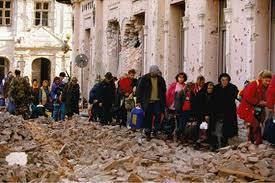
The Battle of Vukovar (Croatian: Bitka za Vukovar, Serbian: Битка за Вуковар) was an 87-day siege of Vukovar in eastern Croatia by the Yugoslav People's Army (JNA), supported by various paramilitary forces from Serbia, between August and November 1991. Before the Croatian War of Independence the Baroque town was a prosperous, mixed community of Croats, Serbs and other ethnic groups. As Yugoslavia began to break up, Serbia's President Slobodan Milošević and Croatia's President Franjo Tuđman started to pursue nationalist politics. In 1990, an armed insurrection was started by Croatian Serb militias, supported by the Serbian government and paramilitary groups, who seized control of Serb-populated areas of Croatia. The JNA began to intervene in favour of the rebellion, and conflict broke out in the eastern Croatian region of Slavonia in May 1991. In August the JNA launched a full-scale attack against Croatian-held territory in eastern Slavonia, including Vukovar.
Vukovar was defended by around 1,800 lightly armed soldiers of the Croatian National Guard (ZNG) and civilian volunteers, against 36,000 JNA soldiers and Serbian paramilitaries equipped with heavy armour and artillery. During the battle shells and rockets were fired into the town at a rate of up to 12,000 a day. At the time it was the fiercest and most protracted battle in Europe, and Vukovar was the first major European town entirely destroyed since the Second World War. When Vukovar fell on 18 November 1991, hundreds of soldiers and civilians were massacred by Serb forces and at least 31,000 civilians were deported from the town and its surroundings. Vukovar was ethnically cleansed of its non-Serb population and became part of the self-declared Republic of Serbian Krajina. Several Serb military and political officials, including Milošević, were later indicted and in some cases jailed for war crimes committed during and after the battle.
The battle exhausted the JNA and proved a turning point in the Croatian war. A ceasefire was declared a few weeks later. Vukovar remained in Serb hands until 1998 when it was peacefully reintegrated into Croatia. It has since been rebuilt but has less than half of its pre-war population and many buildings are still scarred by the battle. Its two principal ethnic communities remain deeply divided and it has not regained its former prosperity.
See article from source: Battle of Vukovar


